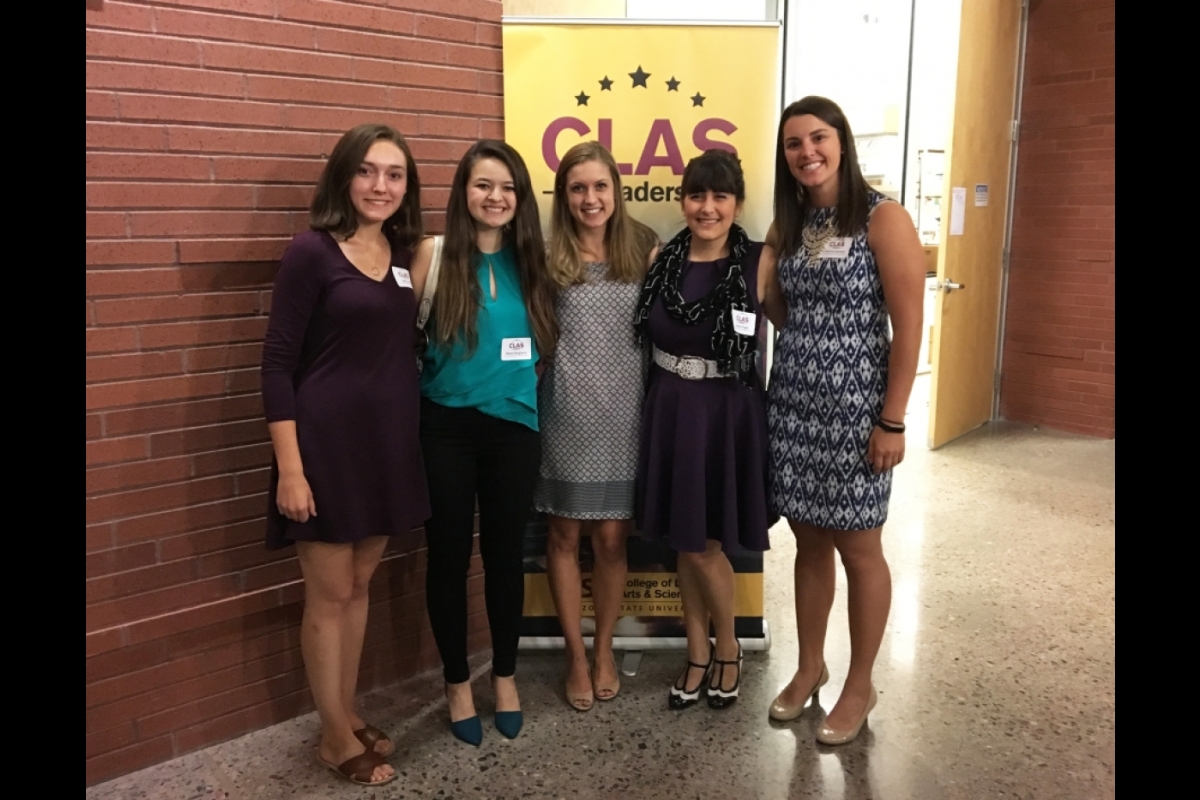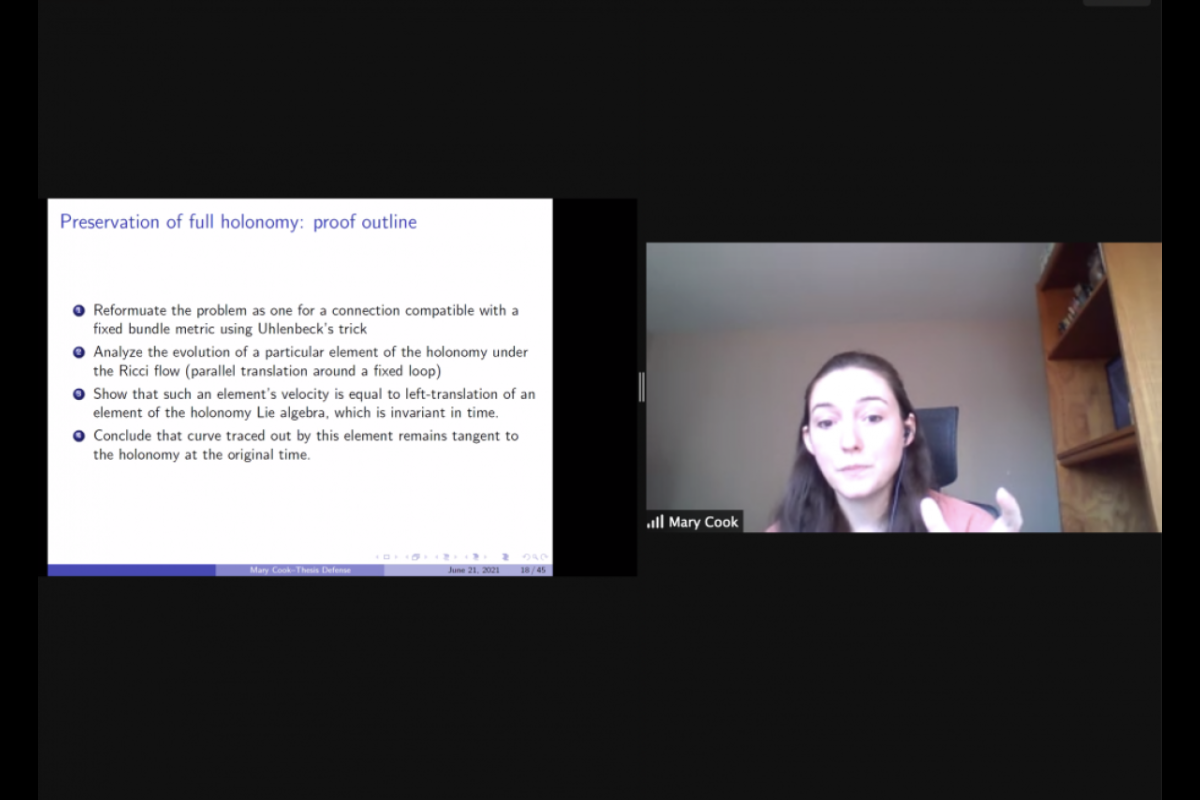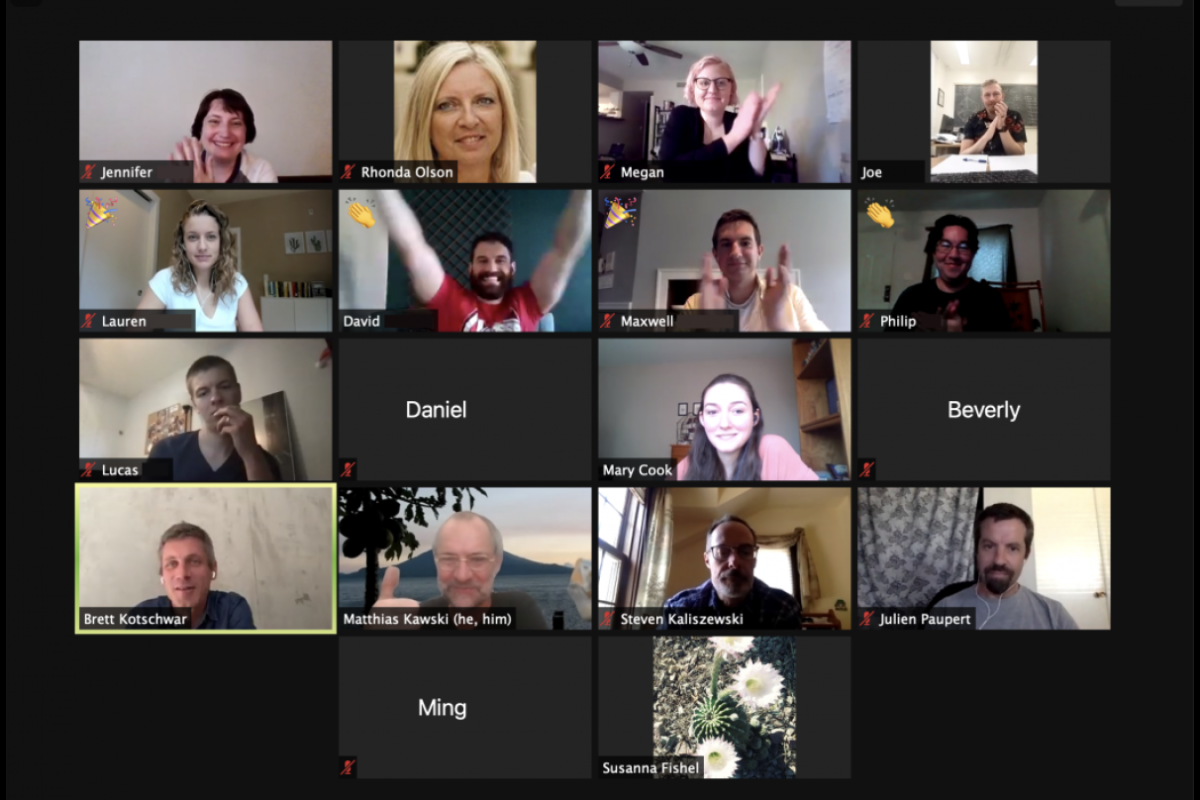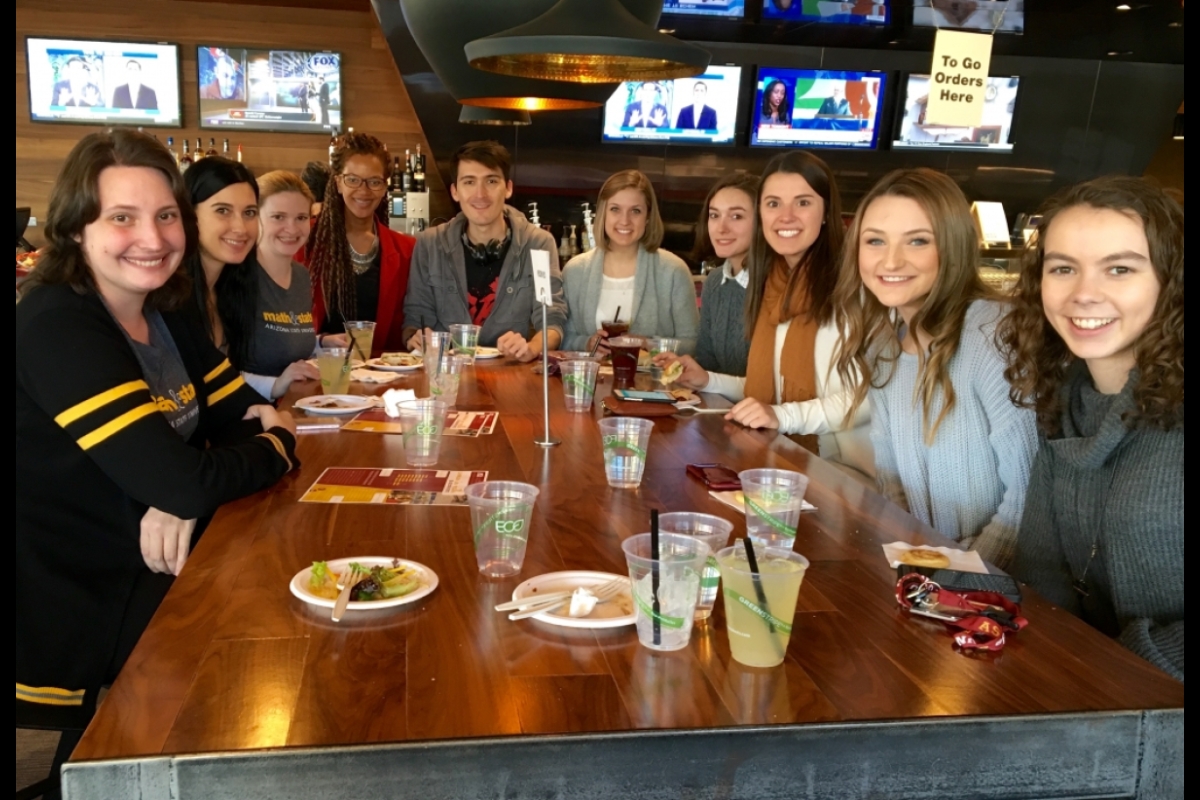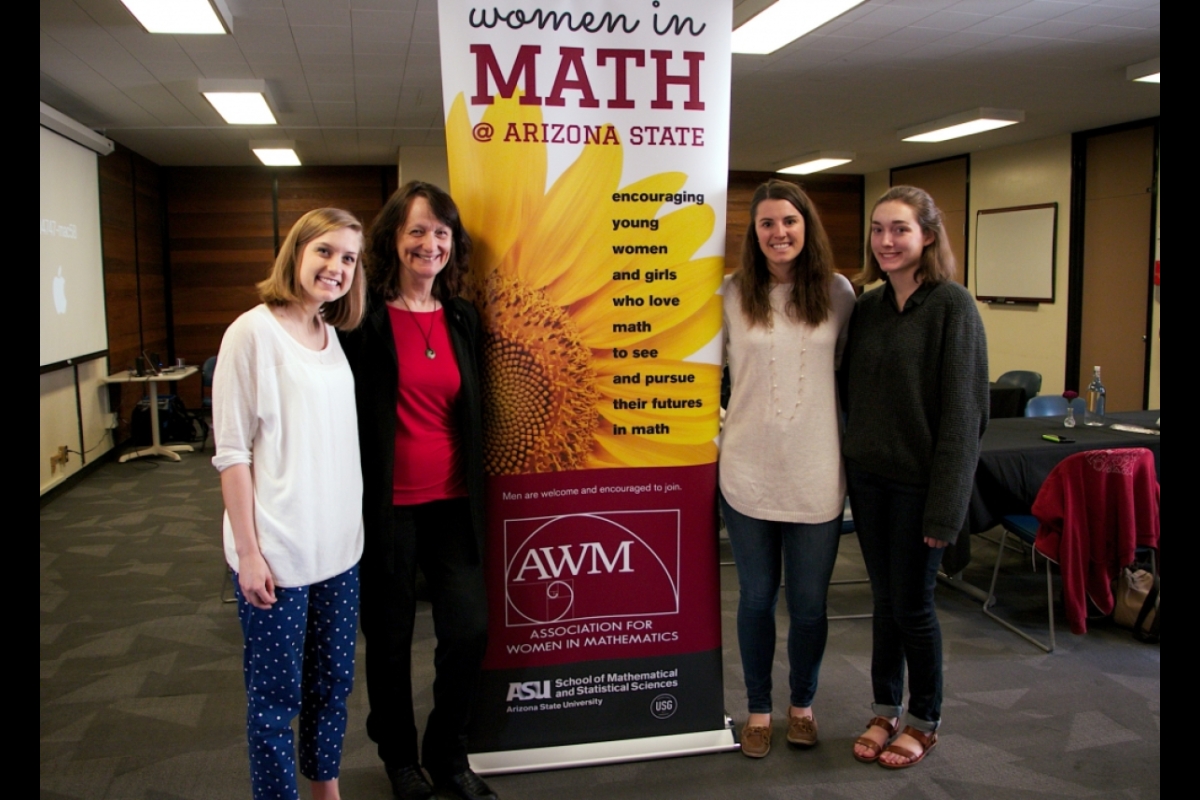Math PhD grad started with passion for music

Mary Cook draws hyperbolic space using sidewalk chalk during ASU's Homecoming Block Party. Photo courtesy of Lauren Crider
When Mary Cook moved across the country from Nashua, New Hampshire, to attend Arizona State University, she planned to major in music. After an in-person visit to meet Professor Martin Schuring, she was so impressed with his playing and teaching that she decided to study oboe with him.
After her first year as a music major, she started to doubt whether she would enjoy life as a career musician. She added a mathematics minor as a way to try something else. Eventually she found out that taking only a few extra classes would allow her minor to turn into a second major. In 2016, she graduated with dual degrees, a bachelor of science in mathematics and a bachelor of music in orchestral performance (oboe).
As an undergraduate, Cook had not even considered applying to graduate school, and certainly not for math. That changed during her MAT 410 topology class with President’s Professor Matthias Kawski.
“Already in the first few weeks Mary was doing extremely well. I knew she was a music-math double major. I wrongly had thought that she would continue with music, the math was just for fun,” Kawski said.
He told her about graduate programs for mathematics, and encouraged her to apply.
Cook decided to stay at ASU and pursue a doctorate in mathematics in the School of Mathematical and Statistical Sciences. She worked with Associate Professor Brett Kotschwar.
During her studies, Cook took a wide variety of classes and found that her favorites were related to geometry and analysis. She also attended the differential geometry seminar fairly often, and that lead to her interest in geometry.
Cook’s research is in geometric analysis, specifically the Ricci flow. The idea is to take a geometric object (imagine something like a lumpy cylinder or sphere) and deform it under very particular rules, and then study the way that it changes.
“Mary is a talented young mathematician and a very creative and independent thinker,” Kotschwar said. “She really impressed me with how quickly she was able to digest new and often very technical material and frame it in her own way.”
Kawski also shared his praise of her work.
“I really liked the way Mary creates and writes arguments in a very personal style, very different from the widely available ‘standard’ proofs. She truly wants to figure out, by herself, what works and why,” Kawski said.
“Mary was one of the true stars of our research group in differential geometry and topology. She gives wonderful presentations always tailored to the audience.
“Mary also substantially contributed to the improvement of community and social life in our school, in particular through her leadership in the AWM program, and participation in many social events sponsored by AWM.”
Cook was part of a small group of young women who re-ignited the Association for Women in Mathematics student chapter at ASU, serving as vice president. Members of the student chapter learned about the complex problem of underrepresentation of women in mathematics and the many contributing factors. The club hosted a speaker series featuring nationally known mathematician and author Eugenia Chang, and president of the national association, Ami Radunskaya, among others.
During graduate school, Cook stopped playing oboe and taught herself the violin, which she played as a member of the ASU Philharmonia orchestra.
Cook was also selected as a student leader of The College of Liberal Arts and Sciences. She volunteered at many events including the ASU Homecoming Block Party and Open Door, where she led engaging, thoughtful and fun math activities for the general public.
Cook graduated this summer with a doctorate in mathematics. Like many others in the era of COVID-19, she defended her thesis "Some Questions on Uniqueness and the Preservation of Structure for the Ricci Flow" virtually via Zoom.
She will be starting as a visiting assistant professor at the University of Rochester this week. She is excited to move closer to her family in Rhode Island.
“We will be able to take a train or drive to see them, much nicer than the long flight from Phoenix,” Cook said.
She plans to try to stay in academia after her postdoc.
“I guess my ‘dream job’ would be to continue working at a university in some way,” Cook said. “But, if that doesn't work out, I would really like to continue teaching, maybe at the high school level.”
"She has graded for me for many courses. I love the different-colored inks she uses for her comments in a beautiful handwriting, very polite, but always to the point," Kawski said. "She has served as a great role model and mentor for many of my students."
“Mary is a natural in the classroom and an unfailingly positive person to be around,” Kotschwar said. “Our program was very lucky to have a student of her caliber. My job as an adviser was really a very easy one.”
Before Cook headed back East, we asked her to share a bit more about her journey as a Sun Devil.
Question: What do you like most about mathematics?
Answer: I like how when working on a problem, it becomes more like a game than work. You know the result you want, but there are so many possibilities to get there.
Q: What is something you learned while at ASU that surprised you or changed your perspective?
A: Though I think on some level everyone knows this, I was surprised to see firsthand that everyone, even the most brilliant mathematician, makes mistakes. When I was younger, I thought that at some point I would reach a level where I no longer made any errors, but that point never came. It's really freeing to realize that this is true for everyone.
Q: Which professor taught you the most important lesson while at ASU?
A: It's hard to pick a lesson which is the most important, but my adviser (Brett Kotschwar) has taught me so much over these years. One thing that stands out is that he taught me not to downplay my own work, which is something I've struggled with a lot.
Q: What is the best piece of advice you would give to those still in school?
A: Don't be afraid to ask questions or ask for help. Many students seem to be nervous to ask a question in front of an entire class, but chances are, others will be wondering the same thing and be glad you spoke up.
Q: What was your favorite spot on campus, whether for studying, meeting friends or just thinking about life?
A: My favorite spot is my office. It's a peaceful place to work, and there are always other students around to talk to when I need a break.
Q: What do you like to do in your spare time for fun?
A: My favorite hobby is playing music. I'm looking forward to playing in community orchestras again now that some of them are starting back up!
Q: What do you think is most misunderstood about math by the general public?
A: I think most people don't realize how much creativity goes into doing math. I think most people imagine that mathematicians sit around all day adding really big numbers together or something like that, but in reality writing proofs requires a lot of creative thinking.
More Science and technology

ASU-led space telescope is ready to fly
The Star Planet Activity Research CubeSat, or SPARCS, a small space telescope that will monitor the flares and sunspot activity…

ASU at the heart of the state's revitalized microelectronics industry
A stronger local economy, more reliable technology, and a future where our computers and devices do the impossible: that’s the…

Breakthrough copper alloy achieves unprecedented high-temperature performance
A team of researchers from Arizona State University, the U.S. Army Research Laboratory, Lehigh University and Louisiana State…


